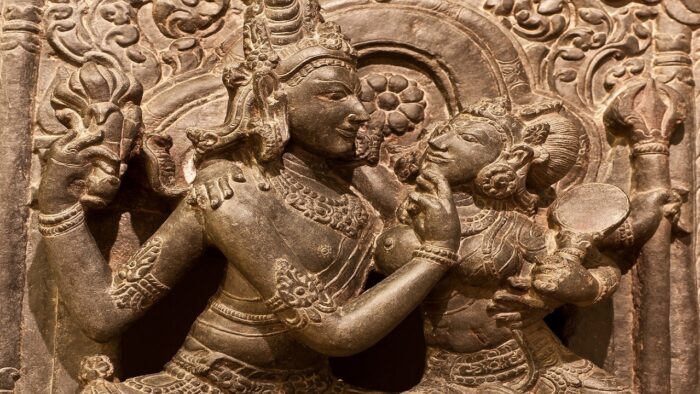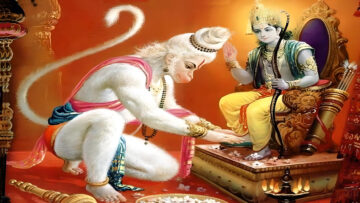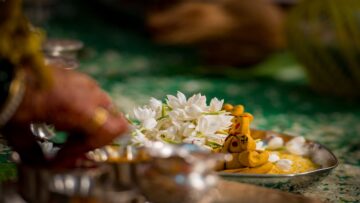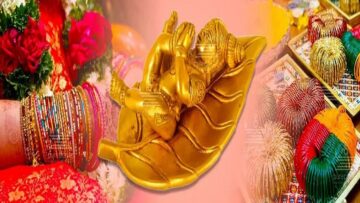We had hitherto focussed on the process of Garbhādhāna. Now, the focus will be on the time that is given for Garbhādhāna and maithuna as per our Śāstras. The volume of the contents herein needed a separate article in dwelling deeper into the finding of proper timing for the process elaborated in our earlier article.
Before exploring about Pañcāṅga, this śloka must be analyzed to realize the importance of the maithuna protocol and Pañcāṅga protocol.
The Factors influencing the nature of the child –
मिथुनस्य मनोभावो यादृक् मदलालसं भवति ।
श्लेष्मादिभिः स्वदोषैस्तत्तुल्यः गुणोनिषिक्तः स्यात् ॥ Kalyāṇa Varmā’s Sārāvali 8/13
This śloka suggests how a child will be formed in terms of the physical and mental health of the couple at the time of maithuna–
- To the couple’s mood and happiness during the coitus. (Mind)
- To the nature of Tridoṣas (Vāta, Pitta, and Kapha) present at that time. (Body)”
Even Jyotiṣa acknowledges the Tridoṣas mentioned in Āyurveda classics.
In a nutshell, intimacy, happiness, and fitness are essential for the conceivable child’s wellness. Tridoṣas also cover mental and physical parameters of health subtly.
An example for the śloka above occurs in Mahābhārata.
Pāṇḍu and Dhṛtarāṣṭra, both were born with a defect because their respective mothers were afraid and not at ease during the coitus.[1]
The timing related to Pañcāṅga is important and at the same time, the health of an individual during maithuna is also important.
Time is essential for anything and everything; we need to have a basic understanding to get started. Also, it is difficult for everyone to comprehend the complexity of the regulations based on Jyotiṣa and precisely make the decision. Time also subtly influences the body and mind.
So, a few selected ślokas have been taken and some tables have been made for a simpler understanding.
When is Maithuna prohibited?
The restrictions given here are based on some Jyotiṣa and Āyurveda regulations and with a seasonal regimen.
उपेयात्पुरूषो नारींसन्ध्ययोर्न[2]चपर्वसु।
गोसर्गेचार्द्धरात्रेचतथामध्यंदिनेऽपिच॥ (Bhāvaprakāśa 5/279)
त्र्यहाद्वसन्तशरदोपक्षाद्वृष्टिनिदाघयोः।
सेवेतकामतःकामःहेमन्तेशिशिरेबली॥ (Aṣṭāṅga Saṅgraha Sūtra Sthāna 9/75)
Sandhyā time =3 Nādikās (72 mins) before Sunrise and 72 mins after Sunset.
Parvās –Amāvāsyā, Paurṇamī, Aṣṭamī, Caturdaśī and monthlySaṅkrānti day.
The time when cows are released from their pens for grazing and, during/at midnight and midday.
Spring and autumn – Once in 3 days. *
Rainy and summer season – Once in 15 days. *
Winter and cold seasons – As per the couple’s desire. *
* But the above three statements have been given only to highlight one’s strength for maithuna. The season-based prohibitions are not that important like Dharma Śāstra prohibitions. When a conflicting opinion occurs between anyŚāstra(including Āyurveda orJyotiṣaetc.) and Dharma Śāstra, the instruction of Dharma Śāstra is said to prevail over the directives of other Śāstras. The general understanding of Śāstras is based on this statement – अनुक्तम् अन्यतोग्राह्यम्।“ That means, wherever a particular injunction is made and is not contradicted in Dharma Śāstra can be taken for practice.”
In this case, Dharma Śāstra does not talk about the time for maithuna in detail as Āyurveda deals with it. Hence, we are bound to adhere to the Āyurvedic injunctions.
The suitable time suggested for maithuna (Based on Āyurveda and relation with weather and climate)
शीतेरात्रौदिवाग्रीष्मेवसन्तेतुदिवानिशि।
वर्षासुवारिदध्वानेशरत्सुसरसःस्मरः॥(Bhāvaprakāśa 5/278)
The recommended time for maithuna as per Āyurveda–
Cold seasons – At night.
Summer – Even daytime. (But avoid this as this statement is contradicted by many other scriptural references. Daytime maithuna affects Brahmacarya power whereas the same is conducive to Brahmacarya at night. [3])
Spring – Day or Night (The daytime is suggested due to the irresistible nature of urge, but it is always ideal to avoid maithuna during the daytime because of Vātaprakopa (it is a state where the body gets exhausted, dry, and weak due to factors like exercise) and rest is needed to recover. Since people might have commitments during the daytime, it may have been advised to avoid.)
Monsoon – When heavy rains with thunder occur.
Night-time at all seasons is valid.
All these are valid only if the sexual urge (in both the partners) is present.
What is a Pañcāṅga in the context of Jyotiṣa?
Pañcāṅga is a calendar that has been created with special formulas to calculate various things and it is very essential for Jyotiṣa and it has five parts.
Pañca = five and aṅga = part. Pañca + aṅga = Pañcāṅga.
The five parts of the Pañcāṅga are Tithi, Nakṣatra, Vāra, Yoga,and Karaṇa.
For Garbhādhāna/Maithuna, knowing the Tithi, Nakṣatra and Vāra prohibitions will suffice to have a good and healthy progeny.
Pañcāṅga Details– Tithis
The colour and case specifications are to be followed for understanding the details given.
BLUE AND UPPER CASE= Permitted tithis.
Orange and underlined= Avoid but only when the female has the urge, have maithuna in these Tithis.
Normal coloured font = Always to be avoided.
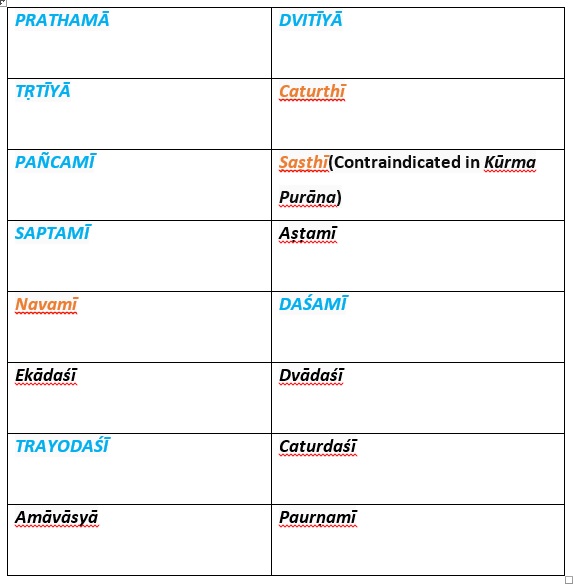
These Tithis are particularly important and monthly Saṅkrānti days are also especially important and avoid maithuna on those days also.
Pañcāṅga Details – Nakṣatras
BLUE AND UPPER CASE= Most favourable Nakṣatrās = 10
Orange and underlined= Moderately favourable = 6
Normal coloured font = 11, to be avoided but not as important as Tithis.
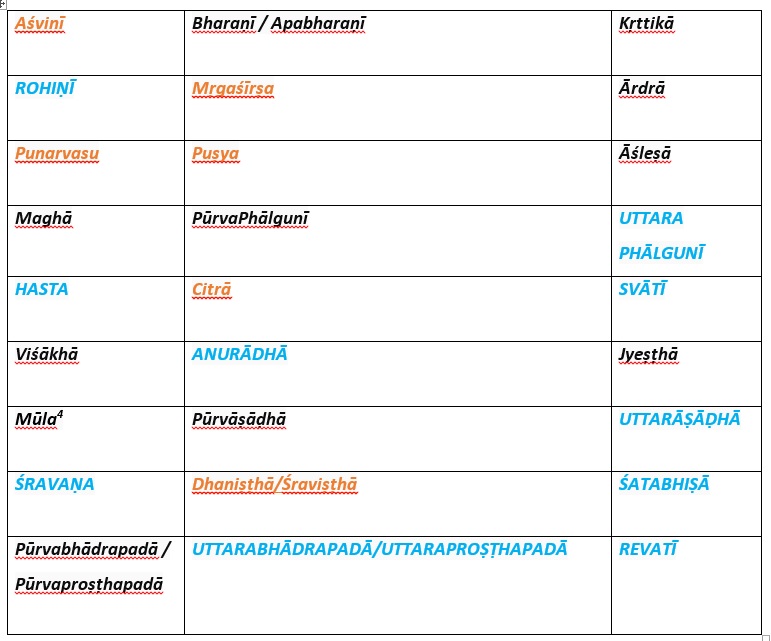
Also, the Janma Nakṣatra, 10thNakṣatra counted from Janma Nakṣatra and 19th Nakṣatra counted from Janma Nakṣatra must be avoided (for both the husband’s and wife’s Nakṣatra). This is incredibly significant.
E.g., If your Nakṣatra is Puṣya, avoid Puṣya, Anurādhā and Uttarabhādrapadā.
The tables are shown below to make things easier to understand. E.g., if you are born in Kṛttikā Nakṣatra then your 10thNakṣatra is Uttara Phālgunī and 19th is Uttarāṣāḍhā.
We are accustomed to pictorial illustrations, hence the tables. Word explanation will not be sufficient for everyone to understand, and the understanding of these tables is particularly useful for many rituals.
Again, if you are Uttara Phālgunī then the 10thNakṣatra is Uttarāṣāḍhā and 19th is Kṛttikā.
Scenario 1 –
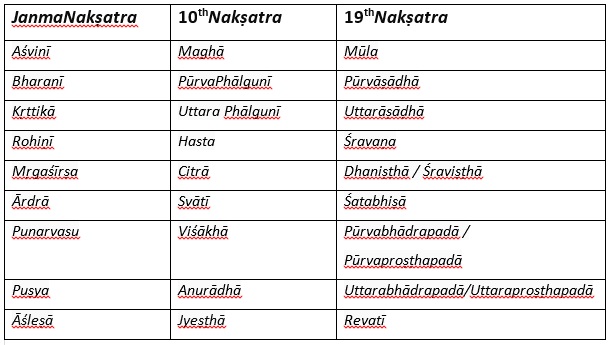
Scenario 2 –
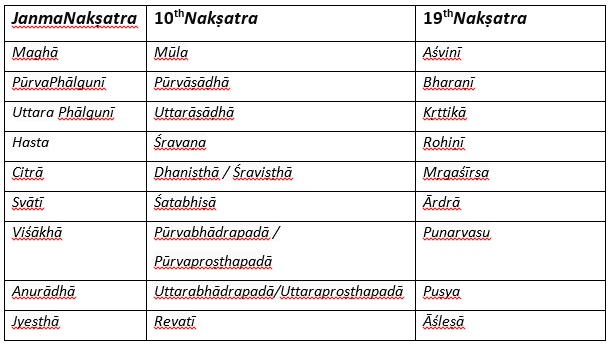
Scenario 3 –

Pañcāṅga Details – Days/Vāra
For days, Monday (Candra), Wednesday (Bhuda), Thursday (Bṛhaspati) and Friday (Śukra) are auspicious and Aṃśas[5] of these planets are also auspicious.
The rest, Sunday (Sūrya), Tuesday (Maṅgala) and Saturday (Śanaiśchara) can be avoided. The Aṃśas of the above planets are also to be avoided.
The days are not important for subsequent maithunas (after the first Garbhadhana samskara) but can be considered if it is possible.
Summary – Compilation of Contraindications
ऋतुकालाभिगमनंपुंसांकार्यंप्रयत्नतः।
सदैववापर्ववर्ज्यंस्त्रीणामभिमतंहितत्। (Bṛhaspati Smṛtiḥ)
“A man may unite with his wife during the Ritu Kāla (avoiding the prohibited days in Ritu Kāla) and during the other nights (even when it is not Ritu Kāla) avoiding the Parvās.” The woman has the maximum decision-making authority here in this regard.
Here is a table of compilations as a summary.
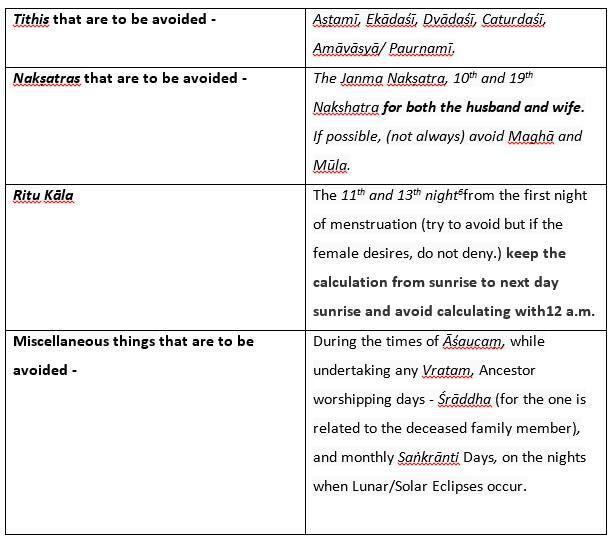
Now, let us ponder over the statement given by Bhagavān Dhanwantari.
धन्वन्तरिरुवाच– This is related to Vṛkṣa Āyurveda (Āyurveda for plant life)
वृक्षायुर्वेदमाख्यास्येप्लक्षश्चोत्तरतःशुभः।
प्राग्वटोयाम्यतस्त्वाम्रआप्येऽश्वत्थःक्रमेणतु॥Agni Purāṇa 282/1
Here, Bhagavān Dhanwantari starts giving a discourse about a plant’s progeny for an effective yield and produce with reference to Nakṣatra, Tithi, etc. More references are there for growing plants and trees in our Śāstras. Even 28thAdhyāya of Sṛṣṭi Khanda, Padma Purāṇa highlights the importance of trees; every plant/tree bestows a unique benefit upon the people involved in nurturing them. When Vṛkṣa Āyurveda deals with the timing for the seed being sown, the same dedication must be shown towards Āyurveda for human beings also, right from the time of conception. This is especially important because human beings have a great responsibility for serving their fellow living beings, परोपकारार्थम् इदं शरीरम्। “The human body is meant for serving the society.”
Kāla (time) is always considered important and calculated to reap the maximum benefits. Our Pañcāṅga provides various details for many auspicious events. Let us also benefit from the proper usage of Kāla in our endeavours.
लोका: समस्ता: सुखिनोभवन्तु।
Lokā: Samastā: SukhinoBhavantu.
[1]Mahābhāratam, Ādiparva, Saṃbhavaparva, Adhyāyaḥ 106
[2]रवेस्तुमण्डलार्द्धास्तात्सायंसन्ध्यात्रिनाडिका।तथैवार्द्धोदयात्पूर्वंप्रातःसन्ध्यात्रिनाडिका॥१४॥
(Definition of Sandhyā – Bṛhatpārāśarahorāśāstram 9/14)
[3]प्राणंवाएतेप्रस्कन्दन्तियेदिवारत्यासंयुज्यन्ते, ब्रह्मचर्यमेवतद्यद्रात्रौरत्यासंयुज्यन्ते।(Praśnopaniṣad)
[4]Favourable and auspicious only for first-time sexual intercourse.
[5]Do not worry about this, (it is important mainly) for the first-time ritual and is usually calculated beforehand by an astrologer. For consecutive times, focus on the compilation summary.
[6]Manu Smṛtiḥ 3/47
Image credit:i-Stock
Disclaimer: The opinions expressed in this article belong to the author. Indic Today is neither responsible nor liable for the accuracy, completeness, suitability, or validity of any information in the article.

